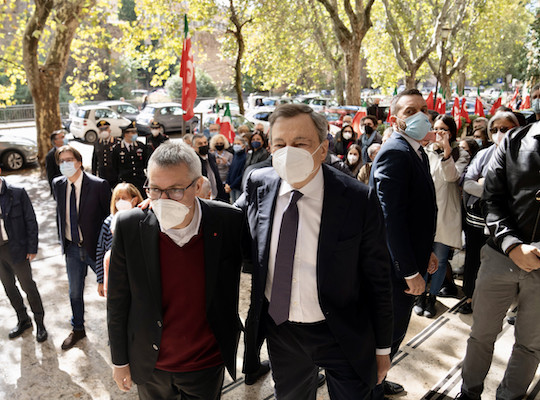On Saturday, October 9th, demonstrators in Rome led by the neo-fascist group Forza Nuova trashed a union building and attacked a hospital emergency room. – eds.
Here is the “eternal fascism” that Umberto Eco warned us against, when he explicated the symptoms of the virus that made Italy the incubator, and then the European model, of an anti-parliamentary regime, violent, anti-freedom, anti-Semitic and warmongering. An endemic virus that has never stopped poisoning democracy by bringing back Roman salutes (useful and hygienic, according to the candidate for mayor of Rome Michetti) in myriad demonstrations and organizing attacks on people committed to fighting for the least powerful, migrants, Roma or those in the social centers.
A virus that today, one hundred years after the first assaults on the Chambers of Labor, is exacerbating social contagion within a pandemic crisis that has stressed the rules of democratic coexistence, with organizations and groups that are trying to harness ignorance and fear in the no-vax rallies, casting themselves as vanguards of the protests, fishing for supporters within a middle class that is impoverished and disintegrated, with the aim to bind them together into a deadly chain, ultimately identifying and hitting the biggest symbolic target: the national headquarters of CGIL. And they stopped barely a few meters away from the Prime Minister’s office at Palazzo Chigi.
What happened in Rome also calls into question the Roman Prefect and the Minister of the Interior. The police forces were insufficient and unprepared, and those who were supposed to control the movements of the Forza Nuova leaders failed to do so.
It’s likely that nobody expected a violent protest with thousands of people. But someone will have to answer for how they handled it. Above all, because the intentions of the Forza Nuova militants and leaders were quite open: it was enough to read the online messages that praised sensational actions against institutional headquarters—in imitation of what happened on Capitol Hill in Washington, after Trump’s defeat: a dress rehearsal for civil war on world television.
Of course, without strong political support, these vanguardist impulses, these neo-fascist groups, would be destined to return to the dustbin where history has confined them. Especially since the pandemic’s grip has been loosened thanks to vaccinations, and the limitations on the freedom of movement of citizens are gradually being reduced. And this perhaps also explains the fury with which the no-vax mob attacked the health staff of the emergency room at the Roman Polyclinic, guilty only of doing their job.
The Italian right, represented in parliament and voted in by millions of Italian citizens, is an extremist, illiberal, nationalist and racist right. They are close and friendly with their other European brothers—as evidenced by the fact that while the headquarters of CGIL was being attacked, Meloni was in Spain at an event organized by Vox, the Spanish movement of Francoist inspiration. And her chilling equivocating statement on the assault on the CGIL, broadcasted on all media, that “I don’t know the originating circumstances of the violence,” certainly does nothing to disprove the view that her own party can be seen as tied to neo-fascist movements. After all, the Fanpage investigation shows that there is a black-shirt underbelly that casts a disturbing light on her party, and which must be fought.
Maybe this time the “march on Rome” mobs will not get away with it. But it’s not a given. Because the dissolution of neo-fascist movements and groups has been called for at other times too, without any result. In the past, for various reasons (not stirring the waters, indifference and inattention towards the problem, lack of strong, incontrovertible legal grounds), the call to outlaw the fascists was taken up only by the organizations of the left, ANPI and this newspaper. How can we forget the battle waged by Luigi Pintor in 1971 against the partisan killer Giorgio Almirante? That initiative was also criticized as giving energy to the fascists, and ultimately favoring Andreotti.
Now the chorus of voices calling for the closure of the branches of Forza Nuova, and similar movements, has become much larger. And the proposal and request for banning these movements that was presented in Parliament will certainly find many supporters. We also support it. Nonetheless, we are well aware that the symbolic value of that act will solve little with regard to the concrete problem of the existence of these groups.
At the same time, it is equally evident that general indignation is not enough, if and when such a major threshold is reached. Not even if the condemnation comes from President Draghi, who has wide support even among the “mainstream” fascist-Lega ranks, who are looking for clever loopholes to distance themselves (purposefully ignoring that among those at that protest, there were thousands of voters of the Lega and Fratelli d’Italia who were applauding the rage-filled and violent slogans shouted from the stage of the fascists in Piazza del Popolo).
Meloni has the tricolor flame of the old MSI as part of her party’s logo, and Salvini is light years away from Umberto Bossi, who actually attended the April 25 demonstration celebrating Italy’s liberation from fascism organized by il manifesto. When Luciano Canfora explains the behavior and the fascistic statements against immigrants by the former Minister of the Interior, he highlights that there is much more at issue than fascist mob violence. There is the conflict between fascism and democracy which, in this second decade of the 21st century, involves politics and the struggles against social inequalities and for the radical change of the economic model.
And because we don’t want everything to end with the rhetoric and the emotions of one day, we will repeat: neo-fascist organizations must be dissolved by the government, before Parliament votes on the bill. Is the national unity of the Draghi government also an anti-fascist unity? They must prove it with action.

